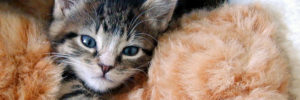Managing Kittens

While the goal of Trap-Neuter-Return (TNR) is to eliminate the birth of kittens in a colony, encountering kittens of various ages is often a normal part of the TNR process. Caretakers may come across young orphaned kittens who need to be taken in to be cared for and bottle-fed. Many caretakers also trap and tame older feral kittens for adoption placement in indoor homes rather than release them back into their colonies after spay/neuter. Removing kittens in this way as the adults in a colony are spayed/neutered and released can support the ultimate success of a TNR project and improve the quality of life for neighborhood residents, caretakers, and cats alike.
During high kitten season in the spring and summer, it’s not unusual to discover a nest of unattended kittens or a single kitten seemingly abandoned by the mother. You want to help, right? Before jumping to the rescue, consider these recommendations.
First: Wait & Watch
You might have come across the kittens while their mother is off searching for food, or is in the process of moving them to a different location. Try to determine if the mother is coming back for them, or if they are truly orphaned.
To do this, stand far away from the kittens — 35 feet or more. If you stand too close, the mom will not approach her kittens. You might need to go away completely before the mother cat will return to attend to the kittens. It might be several hours before the mother cat returns — until she no longer senses the presence of humans hovering near her litter.
If you need to leave before the mother cat comes back, carefully evaluate whether the kittens are in immediate danger: Is it raining or snowing? Are dogs or wild animals that might harm the kittens running loose in the neighborhood? Does the neighborhood have kids or adults who are likely to harm the kittens? Are the kittens located in an area with heavy foot or car traffic?
To help with your decision, it is important to know that it might take several hours for the mother cat to return, and healthy kittens can survive this period without food as long as they are warm. Neonatal kittens are much more at risk of hypothermia than they are of starvation. During spring and summer months, waiting a longer time to see if mom will come back is much safer than during frigid winter months.
The mother cat offers her kittens’ best chance for survival, so wait and watch as long as you can. The best food for the kittens is their mother’s milk. Remove the kittens only if they are in immediate, grave danger.
If the mother cat returns…
If mom returns and the area is relatively safe, leave the kittens alone with mom until they are weaned. You can offer a shelter and regular food to mom, but keep the food and shelter at a distance from each other. Mom will find the food but will not accept your shelter if the food is nearby, because she will not want to attract other cats to food located near her nest.
Six weeks is the optimal age to take the kittens from the mother for socialization and adoption placement, and any time after eight weeks for Trap-Neuter-Return (spay/neuter, vaccination, eartip, and return to their colony). Female cats can become pregnant with a new litter even while they are still nursing, so don’t forget to get the mother cat spayed or you will have more kittens soon! Learn how to socialize kittens and how to successfully trap a mom and her kittens.
If the mother cat does not return…
If you discover that mom has been hit by a car, or if for any reason it appears that she is not coming back, then you should remove the kittens. This is crucial to the kittens’ survival. But you must be prepared to bottle-feed and provide round-the-clock care for the kittens through to weaning if you decide to intervene!
If you take the kittens in and are not prepared to foster them yourself, there are limited options. In general, it is unlikely that you will find an organization with available staff or volunteers to take on bottle-feeding on short notice. Some organizations do have experienced bottle-feeders, but prior logistical planning is necessary. Animal shelters and veterinarians generally do not take in newborn kittens, since they do not have the staff to feed and stimulate them for elimination around-the-clock.
Neonate kittens in New York City have an additional option: the seasonal ASPCA Kitten Nursery. Open from April through October, the Kitten Nursery is for kittens too young to survive on their own as well as nursing mother cats with litters. The Kitten Nursery does not accept kittens from the general public; it only accepts kittens taken in by Animal Care Centers of NYC (ACC), the city’s open-admission shelter system.
Year-round, New York City residents can request assistance through Bideawee’s FCI Help Desk and we will attempt to find someone to bottle-feed the kittens, but this might take days or weeks, and we might not be successful in locating a feeder. If we do find someone to bottle-feed, you might still be responsible for taking the kittens back when they no longer require bottle-feeding. You also might be responsible for paying for veterinary visits, which might include emergency medical care, and will definitely include spay or neuter surgery, disease testing, and vaccinations. And finally, you might be responsible for adopting the kittens into permanent homes. The Feral Cat Initiative can help you locate low-cost veterinary care, and might be able to help you find new homes for the kittens, but completing these tasks will be your responsibility.
Socializing Kittens
Kittens born to community cats need to be socialized (tamed) by humans in order to be suitable for adoption
